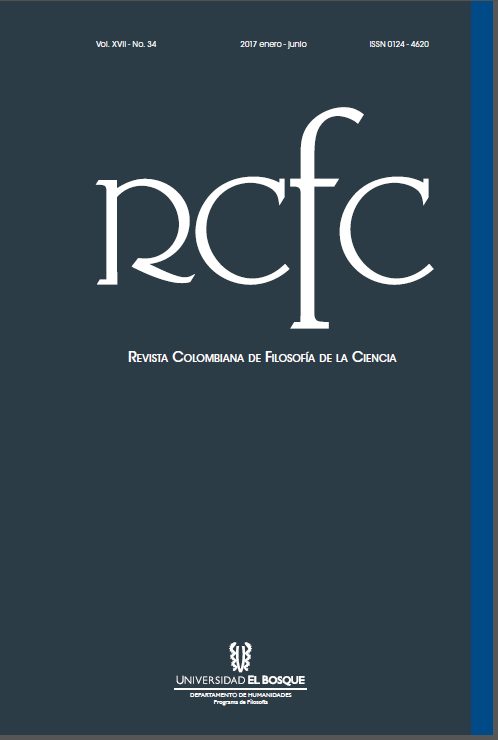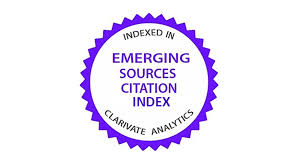La evolución de los sistemas complejos adaptativos según el “darwinismo cuántico” de Zurek
DOI:
https://doi.org/10.18270/rcfc.v17i34.2336Palabras clave:
Darwinismo cuántico, (Neo)-lamarckismo, Selección natural, Información, Sistemas complejos adaptativos.Resumen
En este artículo argumento a favor de una integración no reductiva entre aproximaciones físicas y biológicas, basado en la noción de información como interpretación. Para ello esbozo un esquema fundado en la semiosis de Peirce en el que la relación entre las perturbaciones físicas del entorno, y las respuestas (internas y externas) están mediatizadas por el “sistema de interpretación” que las detecta e interpreta como señales informativas, dando lugar tanto a ajustes estructurales internos, como a acciones implementadas sobre el medio ambiente externo. En consecuencia argumento que los “sistemas de interpretación” pueden equipararse a agentes colectores y usuarios de información de Zurek (IGUS) y a sistemas complejos adaptativos (SCA). Para aplicar este modelo al problema de la adaptación evolutiva examino la teoría de Zurek denominada “darwinismo cuántico” (DC), según la cual el entorno elimina de los sistemas cuánticos la inmensa mayoría de las superposiciones dejando únicamente los “estados preferidos”, entre los cuales se escogen los que de hecho se pueden realizar en el mundo clásico. Elección entre alternativas estructurales accesibles que se deciden en la interacción entre los SCA y su entorno. Para concluir justifico como la semiosis permite aplicar el “darwinismo cuántico” a la evolución de SCA, proponiendo que el debate entre las escuelas (neo)-lamarckiana y neo-darwiniana debe ser repensado en términos más acordes con la física cuántica. Finalmente, la semiosis (es decir la información entendida como interpretación) justificaría la analogía profunda entre los modelos físico-cuánticos y biológicos de evolución adaptativa.
Descargas
Referencias bibliográficas
Alberch, P. “Developmental constraints in evolutionary processes”, en John Tayler Bonner (ed.), Evolution and Development, Berlín: Springer-Verlag. (1982): 313-332.
Andrade, E. “From external to internal measurement: a form theory approach to evolution”. Biosystems, 57. 2 (2000): 49-62.
Andrade, E. Los demonios de Darwin. Semiótica y Termodinámica de la Evolución Biológica. Bogotá: Universidad Nacional de Colombia, 2003.
_____. “On Maxwell’s demons and the origin of evolutionary variations: an internalist perspective”. Acta Biotheoretica. 52 (2004): 17–40.
_____. “Darwin o el falso conflicto entre la teoría de la selección natural y la hipótesis de la pangénesis”. Acta biol. Colomb. 14 (2009a): 63 – 76.
_____. La ontogenia del pensamiento evolutivo. Bogotá: Universidad Nacional de Colombia- Colección Obra Selecta, 2009.
_____. “Integration of Thermodynamic, Quantum and Hierarchical Theories of Information within the Context of Peircean Semiosis”. BioSystems. 120. (2014a): 10-20.
_____. “La vigencia de la metafísica evolucionista de Peirce”. Revista Colombiana de Filosofía de la Ciencia. Vol. 14. 28 (2014b): 83-121.
Anway, Matthew D., Andrea S. Cupp, Mehmet Uzumcu, and Michael K. Skinner. “Epigenetic transgenerational actions of endocrine disruptors and male fertility”. Science 308 (2005): 1466–1469.
Arai, J., Li, S., Hartley, D.M., y L.A. Feig1. “Transgenerational rescue of a genetic defect in long-term potentiation and memory formation by juvenile enrichment”. J. Neurosci. 29 (2009): 1496-1502
Arthur, W. “The concept of developmental reprogramming and the quest for an inclusive theory of evolutionary mechanisms”. Evolution and Development. 2. 1 (2000): 49-57.
Bateson, G. Pasos hacia una Ecología de la mente. Ed. Carlos Lohlé. Buenos Aires: Lúmen, (1976).
Binder, P y Danchin, A. “Life’s demons: information and order in biology”. Embo Reports. 12. 6 (2011): 495-499.
Blackmore, S. The Meme Machine. Oxford: Oxford University Press, 1995.
Bordonaro, M. y Ogryzko, V. “Quantum Biology at the Cellular Level”. Elements of the research program. (2013): 1304.0683 [q-bio.OT].
Brooks, D. & Wiley, E.O. Evolution as Entropy. Chicago: University of Chicago Press, 1988.
Campbell, J. “Quantum Darwinism as a Darwinian process”. Cornell University Library. arXv:1001.0745v1. Cornell University Library. 5 january 2010. Press.
Conrad, M. “Unity of measurement and motion”. BioSystems. 60 (2001): 23–38.
Chalmers, D. J., and F. Jackson. “Conceptual Analysis and Reductive Explanation”. Philosophical Review. 110 (2001): 315–61.
Darwin, D. The Origin of Species by means of Natural selection or the Preservation of Favoured Races in the Struggle for Life. Londres: ElecBook London edition based on the First Edition published by John Murray, 1859.
_____. Animals and Plants Under Domestication. Londres: John Murray, Albemarle street, 1868.
Dawkins, R. The Selfish Gene. Oxford: Oxford University Press, .
Dennet, D. Darwin's Dangerous Idea: Evolution and the Meanings of Life. New York: Simon and Schuster; Londres: Allen Lane, 1995.
Dobzhansky, T. G. Genetics and the origin of species. 3rd ed. New York: Columbia University Press, 1951.
Endler, John. Natural Selection in the Wild. Princeton: Princeton University Press, 1986.
Engel, G.S., Calhoun, T.R., Read, E.L., Ahn, T.K., Mancal T, Cheng, Y.C., Blankenship, R.E., Fleming, G.R. “Evidence for wavelike energy transfer through quantum coherence in photosynthetic systems”. Nature 446 (2007): 782-786.
Everett, H. “Relative State’ Formulation of Quantum Mechanics”. Reviews of Modern Physics. 29 (1957): 454–462.
Gabora, L., Scott, E.O. & Kauffman, S. “A quantum model of exaptation: Incorporating potentiality into evolutionary theory”. Progress in Biophysics and Molecular Biology. 113 (2013): 108 -116.
Gould, S.J. The Structure of Evolutionary Theory. Cambridge, Massachusetts: The Belknap Press of Harvard University Press, 2002.
Heisenberg, W. Physics and Philosophy. Harper Perennial Modern Classics edition, 2007.
Hoffmeyer, J. Signs of Meaning in the Universe. Indiana: University Press, 1996.
Igamberdiev, A.U. “Living systems are dinamically stable by computing themselves at the quantum level”. Entropy 5 (2003): 76–87.
_____. “Quantum computation, non-demolition measurements, and reflective control in living systems”. BioSystems. 77 (2004): 47–56.
_____. “The computation power of living systems is maintained by decoherence-free internal quantum states”. In: FIS Third Conference on the Foundations of Information Science. Paris, 4–7 July 2005.
_____. “Objective patterns in the evolving network of non-equivalent observers”. BioSystems. 92 (2008): 122–131.
Kauffman, S. The Origins of Order: Self-Organization and Selection in Evolution. New York: Ox-ford University Press, 1993.
_____. Investigations. Oxford: Oxford University Press, 2000.
_____. Reinventing the Sacred. A New View of Science, Reason, and Religion. New York: Basic Books, 2008.
Kitto, K. A “Contextualised General Systems Theory Systems”. Queensland University of Tecnology. 18 september 2014. 2 541-565
Longo, G. & Montévil, M. “From physics to biology by extending criticality and symmetry breakings”. Progress in Biophysics and Molecular Biology. 106 (2011): 340-347.
McFadden, J. Quantum Evolution: Life in the Multiverse. Harper Collins. McFadden, J. 2000.
Mcfadden, J. & Al-Khalili, J. “A quantum mechanical model of adaptive mutation”. BioSystems. 50 (1999): 203-211.
Matsuno, K. Internal measurement. In: Protobiology: Physical Basis of Biology. Boca Raton, FL, USA: CRC Press, 1989.
_____. “Forming and maintaining a heat engine for quantum biology”. BioSystems. 85. 1 (2006): 23–29.
_____. “Internalist stance and the physics of information”. BioSystems. 38. 2–3 (1996): 111–118.
Maxwell, J.C. Escritos científicos. Barcelona: Círculo de Lectores. 1999.
Mikulecky, D. “The emergence of complexity: science coming of age or science growing old?” Computers & Chemistry. 25. 4 (2001): 341–348.
Newman, S. Evolution is not Mainly a Matter of Genes. New York Medical College: The 200th anniversary of Charles Darwin, 2009.
Ogryzko, V. “A quantum-theoretical approach to the phenomenon of directed mutations in bacteria (hypothesis)”. Biosystems. 43 (1997): 83-95.
_____. “On two quantum approaches to adaptive mutations in bacteria”. NeuroQuantology. 7. 4 (2009).
Pattee, H. “Evolving self-reference: matter, symbols, and semantic closure”. En Rocha, L. (ed.). Communication and cognition- artificial intelligence (Special issue Self-reference in biological and cognitive systems). 12. 1-2 (1995): 9-27.
Peirce, C. S. “La Arquitectura de las Teorías”. The Monist. Marinés Bayas. I (1891): 161-76; incluido en: CP 6. 7-34.
_____. En: Hartshorne, C., Weiss, P., Burks, A.W. “Collected Papers of Charles Sanders Peirce”. Harvard University Press, Cambridge, MA. (1931–1958):
Raff, R.A. The Shape of Life: Genes, Development, and the Evolution of Animal Form. Chicago: University of Chicago Press, 1996.
Roederer, J.G. “The Role of Pragmatic Information in Quantum Mechanics and the Quantum-Classical Transition” University Cornell Library. arXiv:1108.0991v2. 28 Jul 2012.
Rosen, R. Essays on Life Itself. (Complexity in ecological systems series). New York: Columbia University Press, 2000.
Salthe, S. Development and Evolution. Complexity and Change in Biology. Cambridge: A Bradford Book. The MIT Press, 1993.
_____. “The Spontaneous Origin of New Levels in a Scalar Hierarchy”. Entropy. 6 (2004): 327-343.
_____. “The development (and evolution) of the universe”. Foundations of Science. ( 2010): 15: 357-367.
Sotolongo, P & Delgado, C.J. La revolución contemporánea del saber y la complejidad social. Hacia unas ciencias sociales de nuevo tipo. Buenos Aires: Consejo Latinoamericano de Ciencias Sociales, 2006.
Tegmark, M. The importance of quantum decoherence in brain processes. Phys. Rev.E.. arxiv.org/abs/quant ph/9907009. Cornell University Library. 10 nobember 1999.
Zurek, W.H. “Decoherence and the transition from quantum to classical”. Phys. (1991): 36–44.
_____. “Algorithmic randomness and physical entropy”. Physical Review A. 40. 8 (1989a): 4731 - 4751.
_____. “Thermodynamic cost of the computation, algorithmic complexity and the information metric”. Nature. 341 (1989b): 119-124.
_____. “Decoherence and the Transition from Quantum to Classical—Revisited”. Los Alamos Science. 27 (2002): 1-25.
_____. “Decoherence, einselection, and the quantum origins of the classical”. Reviews of Modern Physics. 75 (2003): 715-775.
_____. “Quantum Darwinism”. Cornell University Library. arXiv:0903.5082. 29 Mar 2009.
Zwolak, M., Quan, H. T. & Zurek, W.H. “Quantum Darwinism in a Mixed Environment”. Physical Review Letters. 103.110402. American Physical Society. 8 september 2009.
Descargas
Publicado
Cómo citar
Número
Sección
Licencia
Derechos de autor 2018 Revista Colombiana de Filosofía de la Ciencia

Esta obra está bajo una licencia internacional Creative Commons Atribución-NoComercial-SinDerivadas 4.0.

| Estadísticas de artículo | |
|---|---|
| Vistas de resúmenes | |
| Vistas de PDF | |
| Descargas de PDF | |
| Vistas de HTML | |
| Otras vistas | |











